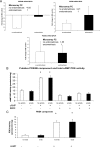The protein kinase A pathway-regulated transcriptome of endometrial stromal fibroblasts reveals compromised differentiation and persistent proliferative potential in endometriosis
- PMID: 20068008
- PMCID: PMC2840687
- DOI: 10.1210/en.2009-0923
The protein kinase A pathway-regulated transcriptome of endometrial stromal fibroblasts reveals compromised differentiation and persistent proliferative potential in endometriosis
Abstract
Intrinsic abnormalities in transplanted eutopic endometrium are believed to contribute to the pathogenesis of pelvic endometriosis. Herein we investigated transcriptomic differences in human endometrial stromal fibroblasts (hESFs) from women with (hESF(endo)) vs. without (hESF(nonendo)) endometriosis, in response to activation of the protein kinase A (PKA) pathway with 8-bromoadenosine-cAMP (8-Br-cAMP). hESF(nonendo) (n = 4) and hESF(endo) (n = 4) were isolated from eutopic endometrium and treated +/- 0.5 mm 8-Br-cAMP for 96 h. Purified total RNA was subjected to microarray analysis using the whole-genome Gene 1.0 ST Affymetrix platform. A total of 691 genes were regulated in cAMP-treated hESF(nonendo) vs. 158 genes in hESF(endo), suggesting a blunted response to cAMP/PKA pathway activation in women with disease. Real-time PCR and ELISA validated the decreased expression of decidualization markers in hESF(endo) compared with hESF(nonendo). In the absence of disease, 8-Br-cAMP down-regulated progression through the cell cycle via a decrease in cyclin D1, cyclin-dependent kinase 6, and cell division cycle 2 and an increase in cyclin-dependent kinase inhibitor 1A. However, cell cycle components in hESF(endo) were not responsive to 8-Br-cAMP, resulting in persistence of a proliferative phenotype. hESF(endo) treated with 8-Br-cAMP exhibited altered expression of immune response, extracellular matrix, cytoskeleton, and apoptosis genes. Changes in phosphodiesterase expression and activity were not different among experimental groups. These data support that eutopic hESF(endo) with increased proliferative potential can seed the pelvic cavity via retrograde menstruation and promote establishment, survival, and proliferation of endometriosis lesions, independent of hydrolysis of cAMP and likely due to an inherent abnormality in the PKA pathway.
Figures




Similar articles
-
Unique transcriptome, pathways, and networks in the human endometrial fibroblast response to progesterone in endometriosis.Biol Reprod. 2011 Apr;84(4):801-15. doi: 10.1095/biolreprod.110.086181. Epub 2010 Sep 23. Biol Reprod. 2011. PMID: 20864642 Free PMC article.
-
Increased mitogen-activated protein kinase kinase/extracellularly regulated kinase activity in human endometrial stromal fibroblasts of women with endometriosis reduces 3',5'-cyclic adenosine 5'-monophosphate inhibition of cyclin D1.Endocrinology. 2009 Oct;150(10):4701-12. doi: 10.1210/en.2009-0389. Epub 2009 Jul 9. Endocrinology. 2009. PMID: 19589865 Free PMC article.
-
Steroidogenic enzyme and key decidualization marker dysregulation in endometrial stromal cells from women with versus without endometriosis.Biol Reprod. 2009 Jan;80(1):105-14. doi: 10.1095/biolreprod.108.070300. Epub 2008 Sep 24. Biol Reprod. 2009. PMID: 18815356 Free PMC article.
-
Endometrial anomalies in women with endometriosis.Ann N Y Acad Sci. 2001 Sep;943:131-47. doi: 10.1111/j.1749-6632.2001.tb03797.x. Ann N Y Acad Sci. 2001. PMID: 11594534 Review.
-
Role of NK cells and HLA-G in endometriosis.Front Biosci (Schol Ed). 2012 Jun 1;4(4):1568-81. doi: 10.2741/s353. Front Biosci (Schol Ed). 2012. PMID: 22652893 Review.
Cited by
-
Differential gene expression in decidualized human endometrial stromal cells induced by different stimuli.Sci Rep. 2024 Apr 2;14(1):7726. doi: 10.1038/s41598-024-58065-z. Sci Rep. 2024. PMID: 38565619 Free PMC article.
-
Molecular evidence for differences in endometrium in severe versus mild endometriosis.Reprod Sci. 2011 Mar;18(3):229-51. doi: 10.1177/1933719110386241. Epub 2010 Nov 9. Reprod Sci. 2011. PMID: 21063030 Free PMC article.
-
Decidualized endometrial stromal cells present with altered androgen response in PCOS.Sci Rep. 2021 Aug 11;11(1):16287. doi: 10.1038/s41598-021-95705-0. Sci Rep. 2021. PMID: 34381107 Free PMC article.
-
Hypomethylation agent decitabine restores drug sensitivity by depressing P-glycoprotein activity through MAPK signaling pathway.Mol Cell Biochem. 2017 Sep;433(1-2):141-148. doi: 10.1007/s11010-017-3022-0. Epub 2017 Apr 12. Mol Cell Biochem. 2017. PMID: 28405849
-
Identification and Analyzation of Differentially Expressed Transcription Factors in Endometriosis.Front Mol Biosci. 2021 Jan 7;7:614427. doi: 10.3389/fmolb.2020.614427. eCollection 2020. Front Mol Biosci. 2021. PMID: 33490107 Free PMC article.
References
-
- Giudice LC, Kao LC 2004 Endometriosis. Lancet 364:1789–1799 - PubMed
-
- Sampson JA 1927 Peritoneal endometriosis due to the menstrual dissemination of endometrial tissues into the peritoneal cavity. Am J Obstet Gynecol 14:422–469
-
- Berkley KJ, Rapkin AJ, Papka RE 2005 The pains of endometriosis. Science 308:1587–1589 - PubMed
-
- Burney RO, Giudice LC 2008 The pathogenesis of endometriosis. In: Nezhat CN, Nezhat FR, Nezhat C, eds. Nezhat’s operative gynecologic laparoscopy and hysteroscopy. New York: Cambridge University Press; 251–257
-
- Eskenazi B, Warner ML 1997 Epidemiology of endometriosis. Obstet Gynecol Clin North Am 24:235–258 - PubMed
Publication types
MeSH terms
Substances
Grants and funding
LinkOut - more resources
Full Text Sources
Other Literature Sources
Medical
Molecular Biology Databases
Research Materials

